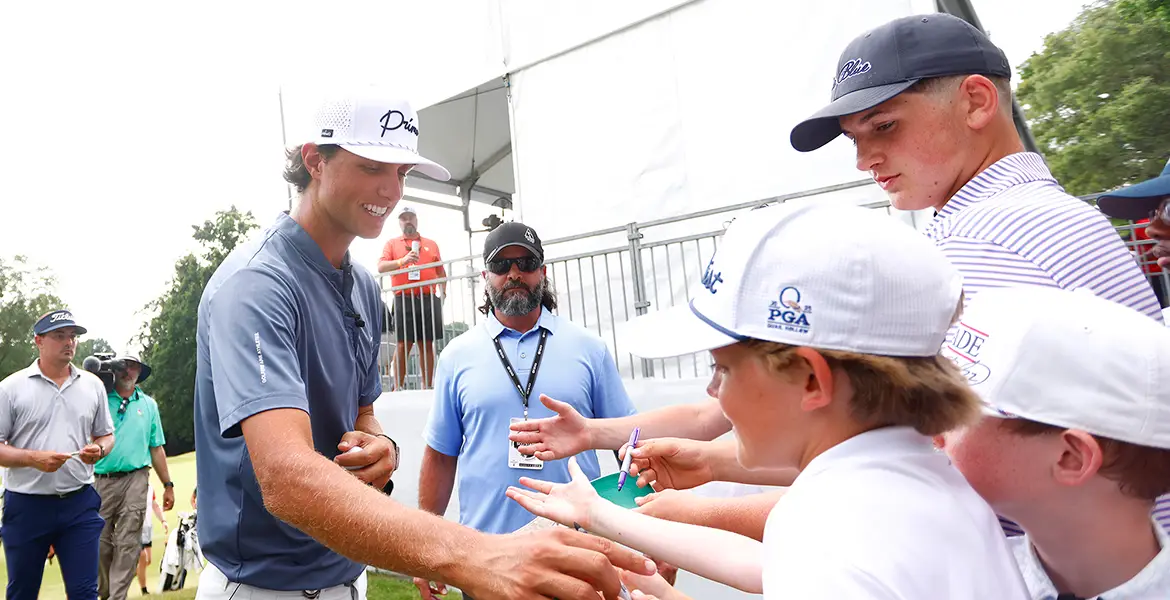The return of the U.S. Open to Congressional Country Club brings to mind one of my formative experiences in golf.
It occurred 35 years ago, the week Dave Stockton won the PGA Championship at Congressional. I’d been hired as a junior editor at GOLF Magazine, and in my first few weeks on the job I’d not only attended the Masters but co-written a series of three instruction articles with the champion, Ray Floyd. (I can still remember the titles of the first two, “Winning with the Woods” and “There’s No Such Thing as a Birdie Hole.” The third one escapes me, so it must’ve been fairly unremarkable.)
Anyway, I’d also gone to the US. Open and watched Jerry Pate hit his fabled 194-yard 5-iron, I’d written my first book and convinced Ben Crenshaw to pen the foreword, and now here I was at Congressional for the PGA. I was making the scene golfwise and feeling rather pleased with myself.
On the Wednesday before the tournament GOLF Magazine held an advertiser outing at the nearby Kenwood Golf & Country Club, and I was enlisted to help with the schmoozing. I don’t recall much about the golf that day, but I’ll never forget my encounter in the grillroom immediately afterward.
Standing alone at the bar was a white-haired gentleman who looked like the senior senator from South Carolina. Tall and barrel chested, with ramrod straight posture despite his 80-plus years, he was clad in a white linen suit that would have made Mark Twain proud and Tom Wolfe jealous.
Assuming he was one of the advertisers—or one of the advertisers’ fathers—I decided I couldn’t ignore him. Besides, I needed a post-round beer, so I bellied up next to him and introduced myself.
“Ah yes, the new recruit,” he said. “Welcome to the toy department.”
The toy department! Did this geezer realize who I was? I may have been young but I’d already made my mark. I was a prime-time player on a big magazine in a smoking-hot sport. I was a soon-to-be published author, I was earning almost $17,500 a year! Heck, I even knew Arnold Palmer’s home phone number (although admittedly I hadn’t dialed it—yet). Who was this codger to welcome me to “the toy department”!
“I’m Herb Graffis,” he said.
Oh. That’s who. Just one of the legends of the game. Just one of my heroes. I silently cursed myself for not having recognized him.
Herb Graffis was a golf writer during the era that included Bernard Darwin, Grantland Rice, Henry Longhurst, and Herbert Warren Wind, with a long-running column in the Chicago Sun Times and several books to his credit, including one of the all-time bestsellers, a collaboration Tommy Armour entitled How to Play Your Best Golf All the Time.
But golf writing was only a small part of what Herb Graffis did. During the first half of the 20th Century he was also American golf’s best friend, a visionary who knew what the game needed and had the smarts and guts to make it happen. He founded The National Golf Foundation, founded the Golf Course Superintendents Association, founded the Club Managers Association, and co-founded the Golf Writers Association of America. There have been other visionaries to walk golf’s corridors—George S. May, Fred Corcoran, Karsten Solheim, Mark McCormack, and Deane Beman come quickly to mind—but none of them reached as broadly or deeply as Herb Graffis. In 1977 he became the first golf writer inducted into the World Golf Hall of Fame.
In 1922, when Herb was 26 (the same age I was when I met him) he wasn’t just writing for a golf magazine, he founded one. Along with his brother Joe, he started the Chicago Golfer, selling it four years later to start a magazine called Golfdom, the first publication dedicated to the business of golf. The Graffis brothers published the first U.S. Open program at Olympia Fields in 1928.
In 1933 they started a national magazine, Golfing, which eventually became merged with GOLF Magazine. Since that time, Herb had been the magazine’s godfather, its gray eminence, its living treasure.
“I’m here to speak to your advertisers,” he told me that day at Kenwood, “but I’m very glad to have some time to chat with you.” That began a friendship that lasted until Herb’s death in 1989 at the age of 95.
I’d run into him here and there, talk to him on the phone now and then, and listen to his humorous musings on the things in golf that attracted and distracted him.
“Dear old George,” was the way he always addressed me, despite being 57 years my senior. Then he’d launch into a series of musings on the things in golf that attracted and distracted him. We always agreed that golf would be more fun, less expensive and therefore more welcoming to the masses if the set of clubs were reduced from 14 to seven, but that idea never gained traction with the equipment companies. Herb was a tireless supporter of the green superintendent—his most quoted line may be: “The most significant invention in the history of golf was the lawnmower.” And one of his most ardent crusades was to create “golf gardens,” public places where the whole family could come and spend the day in a relaxed beer-garden atmosphere that combined a bit of instruction and practice with a playground for the kids and a café/bar for the adults. “We need to make this damned games less intimidating, more welcoming and more fun,” he said, and of course he was right.
Herb was never much of a player but he loved the game and knew its vagaries. “The average man has about as much chance of making a hole-in-one as he does of reading the Rules of Golf,” he said. Ironically, his own hole-in-one went completely unnoticed because it occurred on the same day as Lindbergh’s transatlantic flight.
“I’ve never forgiven Lindy for that,” Herb was fond of saying.
For the last ten years or so of his life his eyesight failed to the point that he didn’t get around much. “I don’t play golf anymore, “ he said once. “I’ve lost my three regular golf buddies, and my vision is so lousy, I could never find three more.”
But his mind remained vivid and he wrote letters—crazy, rambling letters, musing on what attracted and distracted him, laced with profanity and brilliance and composed on a typewriter with giant keys that produced headline type that he edited with a red felt-tipped pen. To receive a thick envelope from 3 Little Carlos Lane, Ft. Myers Beach, FL always guaranteed a few minutes of joy. I wish I’d saved those letters, which always ended the same way: “Cheers to the cellmates” followed by a huge red HERB.
From Herb Graffis I learned to think big, to constantly question the way things worked, that golf was a business as well as a game, and that the worst mistake I could make as an editor would be to confuse my own tastes, wants, and needs with those of the readers. And most of all to remember to try not to take myself too seriously and that when all was said and done, I worked in the toy department.
That evening at the Kenwood Golf & Country Club, the man known as The Toastmaster of Chicago regaled the GOLF Magazine ad reps and their clients with 20 minutes of ribald humor and insight. I can’t remember most of it, but I do recall his parting words which were quintessential Graffis.
“In conclusion, gentlemen, let me assure you that there is no part of an advertiser’s body that I have not kissed.”






